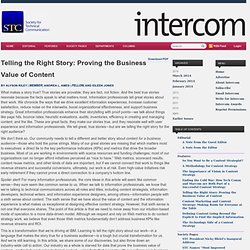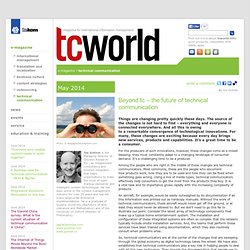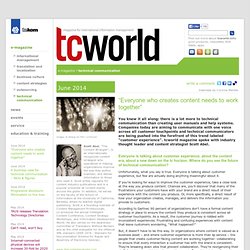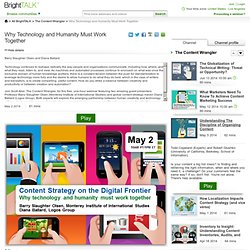

Personalization vs Persona-ization - Mura Marketing Edition. Search is Not Enough: Why We Need Multimodal Navigation. Last week I wrote about the death of hierarchy as the dominant form of content organization.

One of the comments on that post asked me to “comment on the different perspectives between this blog post and “Search is not enough” by the Nielsen Norman Group?” Let me get the central question out of the way right up front. I agree. Search is not enough. In fact, there are a lot of things wrong with search. The Nielsen Norman Group article, by Raluca Budiu, decries what she describes as the tendency of websites to minimize navigation and rely on search alone. 1. These are all true. Search does require knowledge of the search space. But the navigation of a hierarchy requires knowledge of the search space as well. In fact, all navigation requires some knowledge of the search space. Search does increase memory load. Where a navigation based on recognition can be particularly effective, however, is in local navigation among topics closely related to each other by their subject matter. How documentation will save the world of cxm. The Future of TechComm in the Content Era – Take 2 - Acrolinx.
Date: Thursday, March 13th Time: Noon Eastern Time (17 Central European Time) Duration: 60 minutes Panelists: Scott Abel, The Content WranglerAndrea Ames, Content Experience Strategist, IBMAnjana Rajan, Consultant, Innovative Information Strategy ConsultingChip Gettinger, VP XML Solutions, SDLPG Bartlett, SVP Product Management, Acrolinx At a webinar last November, this panel discussed the impact of the Content Era on technical communicators – and over 1200 of you signed up!

We were amazed by the level of interest in this topic. The discussion was fascinating, but we were left with dozens of questions we didn’t have time to answer. If technical content has become as important to buyers as marketing content, how can TechComm and Marketing resolve their differences in personality and process and learn to get along? A Panel: The Future of Techcomm in the Content Era - Acrolinx. Proudly sponsored by Acrolinx and SDL Panelists:

Telling the Right Story: Proving the Business Value of Content « intercom. By Alyson Riley | Member, Andrea L.

Ames | Fellow, and Eileen Jones What makes a story true? True stories are provable; they are fact, not fiction. And the best true stories resonate because the facts speak to what matters most. Information professionals tell great stories about their work. We don’t think so. Spoiler alert! This is a transformation that we’re driving at IBM. The Future of TechComm in the Content Era – Take 3 - Acrolinx. Date: Thursday, July 31stTime: 12pm ET Panelists: Scott Abel, The Content WranglerAndrea Ames, Content Experience Strategist, IBMAnjana Rajan, Consultant, Innovative Information Strategy ConsultingChip Gettinger, VP XML Solutions, SDLPG Bartlett, SVP Product Marketing, Acrolinx Each time this panel gets together to discuss the future of Technical Communications, the response is overwhelming.

For our first two meetings, over 1900 of you signed up! And each time we get together, we’re left with so many questions that we need to meet again. How do we avoid “dumbing down” or “marketizing” our technical content so that it’s no longer credible? To join us for another lively and intriguing discussion, please register for our complimentary webinar. Tcworld.info - technical communication.
For the producers of such innovations, however, these changes come as a mixed blessing: they must constantly adapt to a changing landscape of consumer demand.

It's a challenging time to be a producer. Among the people who are right in the middle of these changes are technical communicators. Most commonly, these are the people who document how products work, how they are to be used and how they can be fixed when something goes wrong. Using a mix of media types, technical communicators effectively help consumers to get the most from the products they buy.
It is a vital task and its importance grows rapidly with the increasing complexity of products. An aircraft, for example, would be easily outweighed by its documentation if all this information was printed out as hardcopy manuals. Content Isn’t King, Content Is a Product. The content as king metaphor has been with us in the Web world for decades, at least since Bill Gates mentioned it in his landmark content article from 1996.

Old guard media leader Sumner Redstone may have even coined the phrase prior to Gates’ article. No matter who said it first, the metaphor’s always been problematic. After all, no one has to obey your content or even pay attention to it. If content is king, then it’s like the king on a chessboard: important but ultimately not very powerful. If we want to keep content from becoming merely another design element, we need a new philosophy. Content is a Product—Treat it Like One How many times have you had to rely on your proposed UX to lead the content producers in their creation process rather than the other way around? Tcworld.info - technical communication - Future of Tech Comm. Everyone is talking about customer experience, about the content era, about a new dawn on the tc horizon.

Where do you see the future of technical communication? Unfortunately, what you say is true. Everyone is talking about customer experience, but few are actually doing anything meaningful about it. If you're looking for ways to improve the customer experience, take a close look at the way you produce content. Chances are, you'll discover that many of the frustrations your customers have with your brand are a direct result of their experience with the content you produce. According to Gartner, 90 percent of organizations don't have a formal content strategy in place to ensure the content they produce is consistent across all customer touchpoints.
But, it doesn't have to be this way. Technical communicators create content that prospects and customers consume. How will the work of technical communicators change over the coming years? The work will remain much the same. LocWorldTweets. Smashing Silos: Improving Communication Between Teams in the Same Organization. Understanding The Discipline of Organizing Content. If you're still hand-crafting content for each individual channel, device, and audience segment, you're doing it wrong.

You’re preventing yourself from becoming the lean, mean, content-producing machine you need to be in today's hyper-connected global marketplace. Today, we can optimize content so it's ready to be put to work on almost any device. Organizations that create intelligent content can push content to desktop computers, laptops, notebooks, tablets, phablets, eBook readers, smartphones, smart watches, smart televisions, and smart automobiles. Not to mention public kiosks, touch-screen signage, voice mail systems, and devices designed to assist the hearing and vision impaired. Oh, and to printers. Why Technology and Humanity Must Work Together. If you're still hand-crafting content for each individual channel, device, and audience segment, you're doing it wrong.

You’re preventing yourself from becoming the lean, mean, content-producing machine you need to be in today's hyper-connected global marketplace. Today, we can optimize content so it's ready to be put to work on almost any device.